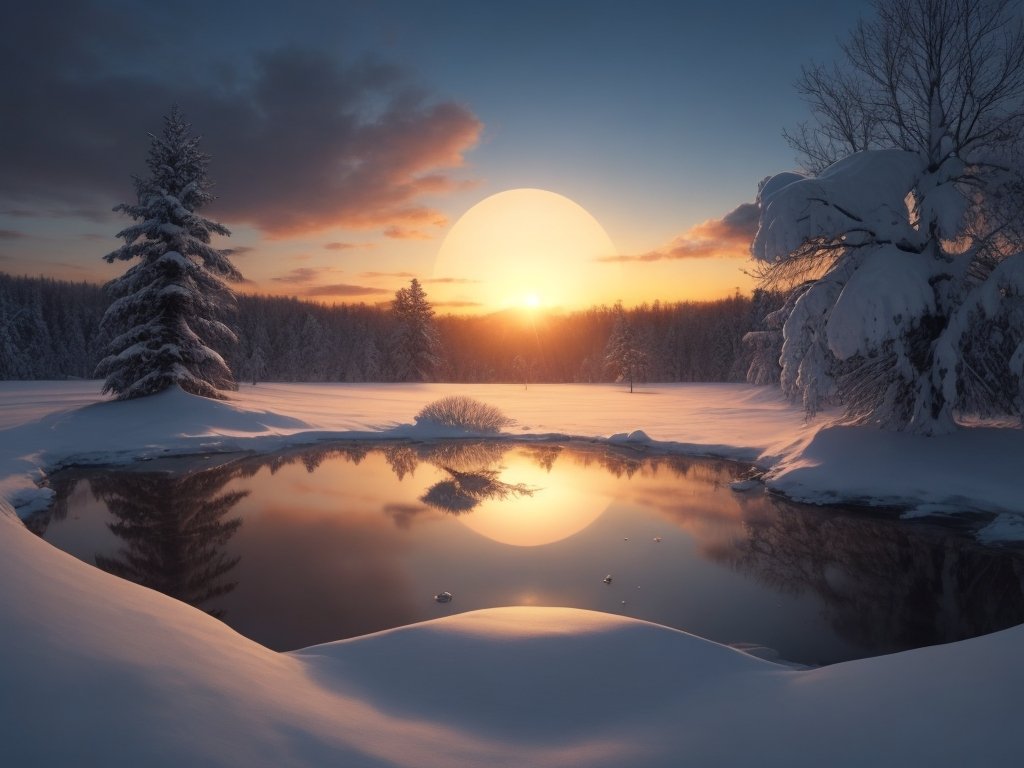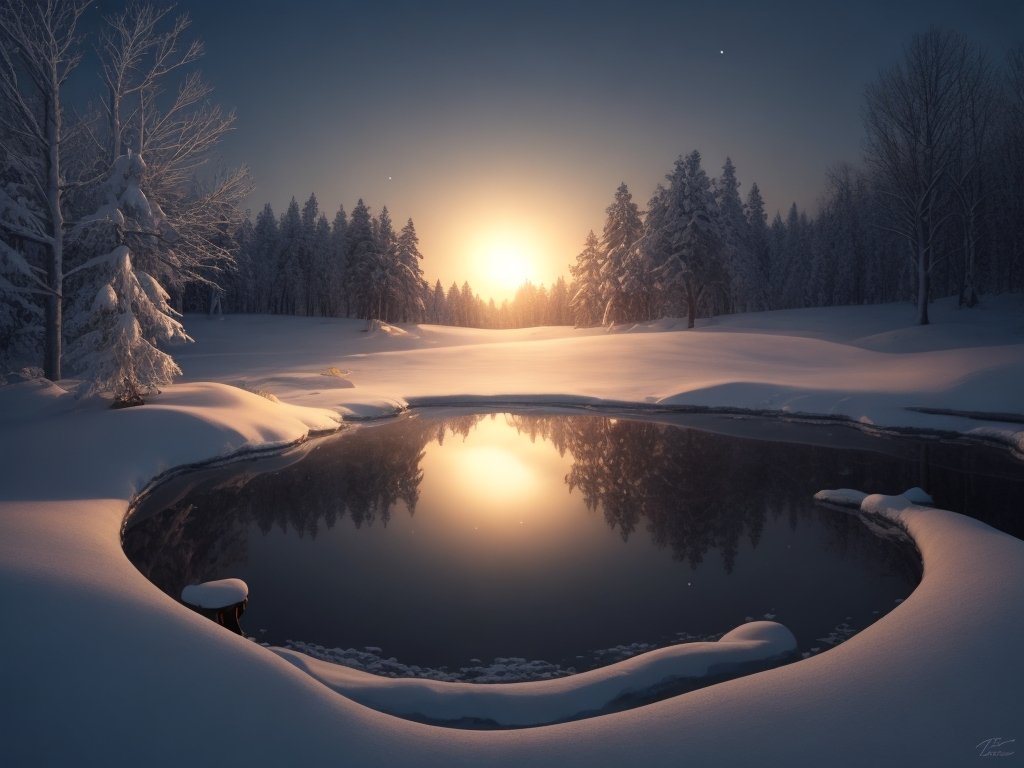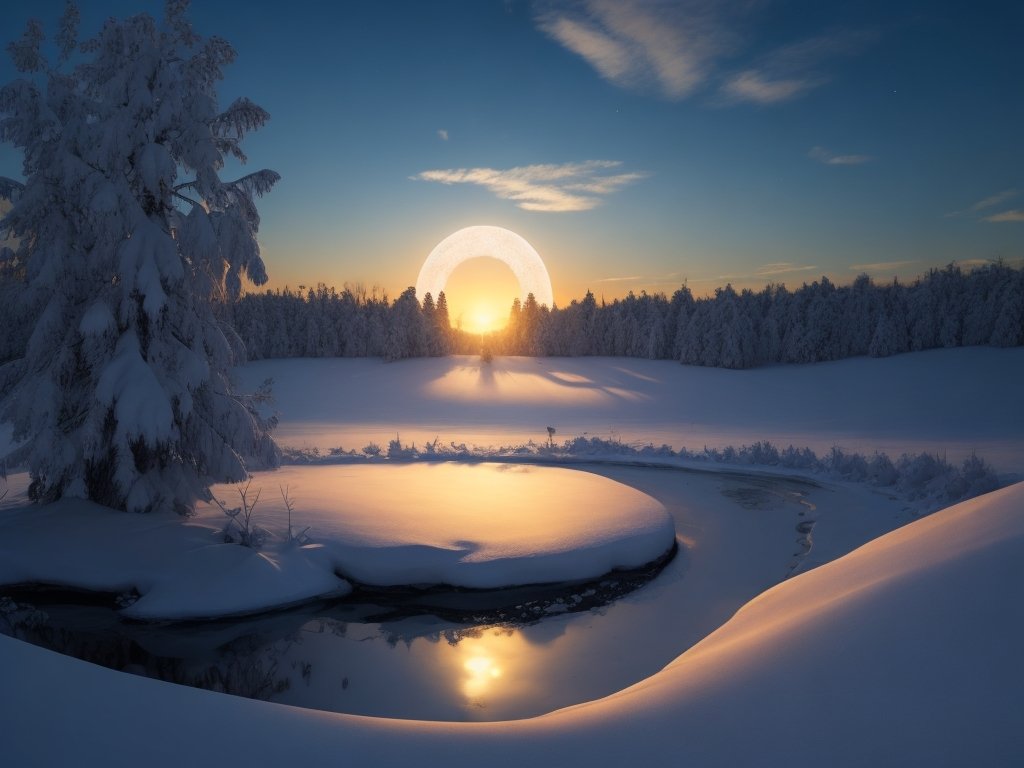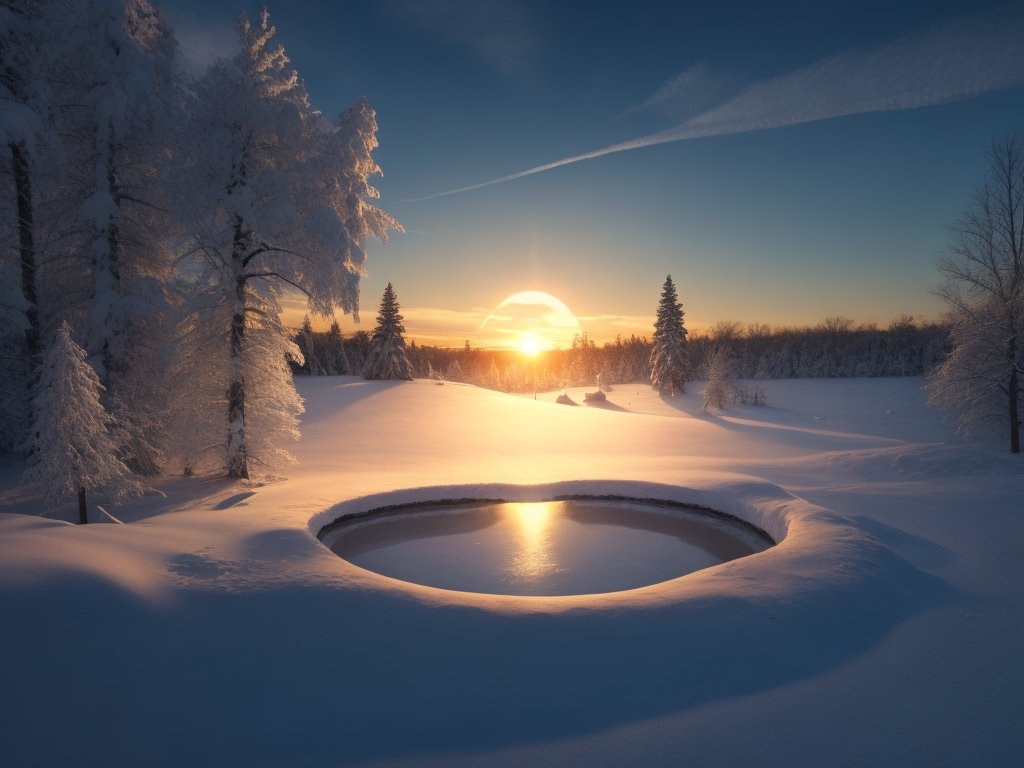Winter Solstice Spiritual Meaning- Explore The Hidden Significance
The Winter Solstice holds deep spiritual significance as the shortest day and longest night. It symbolizes renewal, rebirth, and the return of light. Across cultures, it’s a time for introspection, letting go of old patterns, and welcoming new beginnings. This celestial event encourages inner transformation and celebrates the cycles of nature and life.
As the sun’s journey halts, ancient echoes stir within us. The Winter Solstice isn’t just a date on the calendar; it’s a beckoning, an invitation to peer inward. Like a symphony of shadows and light, it mirrors our own journey – one of growth, introspection, and transformation.
Join us as we venture into the heart of the Winter Solstice’s spiritual significance. Beyond the astral alignments and celestial mechanics, lies a deeper resonance. Through this exploration, we’ll uncover the unspoken yearnings that stir within us, the longing for change and growth that mirrors the world around us.
Key Takeaways
- The solstice symbolizes fresh starts and shedding old patterns.
- It encourages introspection and personal transformation.
- Like nature’s rhythm, life moves in cycles of growth and change.
- Diverse cultures honor this event for its deeper significance.
- Aligning with the solstice connects us to Earth’s natural rhythms.
- It hints at unity in consciousness and our place in the universe.

What Does The Winter Solstice Mean Spiritually?
As the world tilts and the sun’s journey pauses, the Winter Solstice holds profound spiritual meanings that resonate across cultures and beliefs. Beyond its astronomical occurrence, this celestial event acts as a doorway to the depths of our souls. It invites us to explore the interconnectedness of the universe and our place within it.
A Pause for Reflection
Just as nature takes a breath during the solstice, we’re encouraged to pause and reflect on our own journey. This moment in time serves as a reminder that life is a series of cycles – birth, growth, death, and rebirth. It prompts us to assess our own path, shedding old patterns that no longer serve us and making space for new beginnings.
Symbolism of Rebirth
The solstice’s alignment with the return of light after the longest night is more than a cosmic phenomenon. It mirrors our personal journeys of renewal and transformation. Like the world emerging from darkness, we too can emerge from our challenges with newfound strength and insight. The solstice thus becomes a powerful symbol of resilience, hope, and the potential for positive change.
Embracing Unity and Connection
This celestial event reminds us of our interconnectedness with the universe. Just as the Earth aligns with the cosmos, we too are part of a larger cosmic dance. The solstice encourages us to transcend individual boundaries and embrace unity consciousness – a realization that we are all interconnected and part of a greater whole.
Harnessing Natural Energies
Aligning with the solstice allows us to tap into the energies of nature’s cycles. It’s a time to harness the revitalizing energy of the returning light and infuse it into our own lives. Whether through meditation, rituals, or personal intentions, we can align ourselves with the natural rhythms of the Earth to foster personal growth and transformation.
Rekindling the Flame Within
As the world celebrates the return of sunlight, the solstice prompts us to ignite our inner flame. It’s a call to awaken our passions, pursue our dreams, and let our light shine brightly. Just as the sun’s warmth brings life back to the Earth, embracing our inner light can inspire positivity, creativity, and a sense of purpose.
In essence, the Winter Solstice isn’t merely a moment on the calendar – it’s a canvas upon which we can paint our spiritual intentions and aspirations. It’s a reminder that we are part of a grander tapestry of existence, woven with threads of transformation, unity, and the eternal dance of light and darkness.
5 Interpretations Of The Spiritual Meaning Of The Winter Solstice
The Winter Solstice is more than a cosmic event; it’s a profound tapestry woven with spiritual significance. As the world pauses in its celestial dance, it invites us to peer inward and contemplate the deeper meanings this moment holds. Here, we delve into five interpretations of the Winter Solstice’s spiritual essence, each offering a unique perspective on its transformative power and the wisdom it imparts.
| Interpretation | Description |
| Renewal and Rebirth | The solstice symbolizes a fresh start, shedding old patterns and embracing new beginnings. Just as the sun’s journey pauses before returning, it encourages us to reflect on our personal growth and transformation. |
| Inner Illumination | Like the returning light, the solstice calls us to awaken our inner light and wisdom. It’s a time for introspection, self-discovery, and tapping into our innate potential for personal and spiritual growth. |
| Unity and Connection | Aligning with the solstice reminds us of our interconnectedness with the universe. It encourages unity consciousness, the recognition that we are all part of a greater whole, and fosters a sense of harmony with the cosmos. |
| Embracing Change | Just as the seasons change, the solstice signifies the cyclical nature of life. It prompts us to embrace change, release what no longer serves us, and welcome new opportunities with an open heart and mind. |
| Rituals and Intentions | Many cultures use the solstice as a time for rituals, ceremonies, and setting intentions. It’s an opportunity to align our energy with the natural rhythms of the Earth, harnessing its energies for personal growth, healing, and transformation. |
As the solstice aligns the physical and the spiritual, we find ourselves standing at the threshold of renewal and reflection. From the symbolism of rebirth to the unity it fosters with the universe, the Winter Solstice invites us to embrace its teachings in our own lives. Whether through inner illumination, embracing change, or setting intentions, the solstice becomes a guidepost on our personal journey of growth and transformation.

Spiritual Meaning Of Winter Solstice In Different Cultures
As the world tilts toward the Winter Solstice, it reveals a rich array of spiritual meanings woven into the fabric of diverse cultures. From the sun’s rebirth in Celtic traditions to Native American gratitude for Earth’s cycles, and the yin-yang harmony celebrated in Chinese culture, this global tableau reflects humanity’s deep connection to the cosmos.
Join us as we explore the profound spiritual significance of the Winter Solstice across cultures, uncovering the threads that unite us in reverence for nature’s rhythms and the mysteries of existence.
| Culture | Spiritual Meaning |
| Celtic | Celebration of Yule, rebirth of the Sun God. |
| Native American | Honoring Earth’s cycles, renewal and gratitude. |
| Chinese | Observing Dongzhi, yin-yang balance and family unity. |
| Inca | Inti Raymi, worship of the Sun God and agricultural cycles. |
| Persian | Yalda Night, triumph of light over darkness. |
Celtic
In Celtic culture, the Winter Solstice, known as Yule, marks the rebirth of the Sun God. It symbolizes the return of light, representing hope and renewal during the darkest days of the year. Yule celebrations involve lighting fires and candles to welcome the Sun’s return and to banish darkness.
Native American
Many Native American tribes view the Winter Solstice as a time to honor the Earth’s cycles. It’s a period of reflection, renewal, and gratitude for the interconnectedness of all life. Ceremonies often include rituals to harmonize with nature and express thanks for the resources provided by the Earth.
Chinese
Dongzhi, the Winter Solstice festival in Chinese culture, emphasizes the balance between yin and yang forces. It’s a time to gather with family, share hearty meals, and welcome longer days ahead. The festival represents unity within the family and the alignment of human life with the natural world.
Inca
In Inca civilization, Inti Raymi is a grand celebration of the Sun God. It honors the Sun’s role in agriculture and life’s sustenance. The solstice marks the start of a new agricultural cycle, emphasizing the importance of balance with nature and the connection between the spiritual and physical worlds.
Persian
Yalda Night, celebrated in Persian culture, symbolizes the triumph of light over darkness. It’s a time for family and friends to gather, share stories, and eat symbolic foods. The night marks the turning point when darkness begins to recede and the return of longer days is celebrated.
In these diverse cultures, the Winter Solstice’s spiritual meaning transcends geographical boundaries, offering a profound connection to the cycles of nature, the cosmos, and the human spirit.

What Does Seeing The Winter Solstice In Dream Mean Spiritually?
Dreams are windows to our subconscious, often revealing hidden meanings and insights. When the Winter Solstice makes an appearance in your dreams, its spiritual significance holds layers of interpretation, each shedding light on your inner journey and connection to the universe.
Symbol of Transformation
Seeing the Winter Solstice in a dream can signify a personal transformation on the horizon. Just as the solstice marks the transition from darkness to light, your dream might be reflecting a shift in your own life – a period of growth, renewal, and shedding old patterns.
Inner Alignment
Dreaming of the Winter Solstice can suggest a need for inner alignment. It’s a cue to pause and assess your inner landscape. Are there areas in your life where you need to realign with your true values and purpose? This dream might be urging you to find your center and embrace the changes that lie ahead.
Embracing Cycles
The appearance of the Winter Solstice could be a reminder of the cyclical nature of life. Just as the seasons change, your dream might be encouraging you to accept the ebbs and flows of your own journey. Embrace the different phases without resistance, knowing that each holds its own lessons and beauty.
Connection to Nature
Dreams of the Winter Solstice can be a signal to reconnect with nature’s rhythms. Consider spending more time outdoors, observing the changing world around you. Your dream might be encouraging you to tap into the Earth’s energy and find harmony within it.
Finding Inner Light
As the solstice symbolizes the return of light, seeing it in a dream can be a metaphor for finding your inner light. Your dream might be prompting you to explore your passions, talents, and sources of inspiration. Embrace your unique gifts and let your inner light shine brightly.
In essence, when the Winter Solstice graces your dreamscape, it carries a potent spiritual message. It urges you to embrace transformation, align with your inner compass, and honor the natural cycles that govern life. Just as the solstice marks a turning point, your dream invites you to embark on a journey of self-discovery and growth.
Brief History Of The Winter Solstice As A Cultural Icon
The Winter Solstice, spanning cultures and civilizations, has stood as a remarkable cultural icon throughout human history. From ancient rituals to modern celebrations, its significance has transcended time, leaving an indelible mark on the tapestry of human heritage.
Ancient Reverence
In antiquity, the Winter Solstice held immense significance. Ancient civilizations like the Egyptians, Greeks, and Romans marked this celestial event with festivals honoring deities of light and rebirth. The Great Pyramids’ alignment with the solstice sunrise showcases the Egyptians’ reverence for its astronomical import.
Sacred Alignments
The solstice’s connection to sacred architecture is profound. Stonehenge, a prehistoric monument in England, aligns with the solstices, suggesting its use as a ceremonial site for acknowledging the cycles of nature. In Machu Picchu, the Intihuatana stone marks the Inca’s acknowledgment of the solstice’s power in their agricultural calendar.
Winter Solstice and Religion
Many religious traditions incorporated the Winter Solstice into their calendars. The Christian celebration of Christmas, on December 25, coincides with ancient Roman festivals like Saturnalia and Sol Invictus, honoring the rebirth of the sun. Similarly, Hanukkah, observed by Jewish communities, holds ties to the solstice’s symbolism of light overcoming darkness.
Modern Celebrations
The Winter Solstice’s cultural legacy endures through modern traditions. Yule logs, symbolic of the returning sun’s warmth, stem from Norse and Celtic practices. Festivals of light, such as Diwali and Hanukkah, continue to honor themes of illumination and hope during the solstice season.
Global Unity
Despite cultural diversity, the solstice unites humanity. Indigenous communities worldwide hold ceremonies honoring the Earth’s rhythms. New Age spirituality embraces the solstice’s spiritual significance, fostering a shared connection to nature’s cycles.
In sum, the Winter Solstice’s journey from ancient reverence to modern celebration exemplifies its enduring status as a cultural icon. It bridges cultures, religions, and eras, serving as a reminder of our shared humanity and the universal connection we have to the cosmos.
The Relevance Of The Winter Solstice As A Spiritual Symbol For Modern Society
In the bustling currents of modern life, the Winter Solstice emerges as a beacon of spiritual significance, offering timeless wisdom that resonates with contemporary souls. Amidst the rapid pace and digital landscapes, this celestial event holds profound relevance as a spiritual symbol that illuminates the path to introspection, connection, and renewal.
Embracing Pause in a Frantic World
As the world accelerates, the solstice presents an invitation to pause. In an era characterized by constant connectivity and information overload, the solstice encourages us to unplug, to step back from the noise and reflect. It offers a precious space for introspection, aligning with the need for mindfulness in a frenetic world.
Rekindling the Inner Light
In the heart of the solstice’s darkness lies a powerful metaphor. Just as the sun begins its ascent from the longest night, modern society can rediscover its inner light. The solstice serves as a reminder to ignite passions, talents, and dreams buried beneath the demands of daily life. It prompts us to let our inner brilliance shine.
Nurturing Connection to Nature
In an era of urban landscapes and digital screens, the Winter Solstice bridges the gap between humanity and the natural world. It nudges us to recognize our interconnectedness with the cosmos and the Earth’s rhythms. By honoring the solstice, modern society rekindles a bond with nature, fostering eco-consciousness and sustainable living.
A Time for Unity and Reflection
In a world often divided, the solstice emerges as a unifying force. Its global significance connects cultures, faiths, and individuals in a shared recognition of the Earth’s journey through the cosmos. This unity encourages empathy, fostering a sense of global kinship and reminding us of our shared human experience.
Igniting the Spark of Change
The solstice’s symbolism of rebirth aligns seamlessly with modern society’s aspirations for change. Just as the solstice marks the turning point from darkness to light, it can inspire collective movements toward positive transformation. From personal growth to societal evolution, the solstice fuels the fires of change.
Finally, the Winter Solstice is not confined to history; it thrives as a spiritual symbol for modern society. In its embrace, we find solace in reflection, empowerment through inner light, and the rekindling of a harmonious relationship with nature. The solstice holds relevance as a guidepost for contemporary souls seeking depth, meaning, and connection in a fast-paced world.

Representation Of The Winter Solstice In Different Mythology
Across the diverse tapestry of human mythology, the Winter Solstice emerges as a thread woven into the stories and beliefs of cultures worldwide. This celestial event finds its place in the narratives of ancient civilizations, offering insights into their understanding of the cosmos and their spiritual outlook.
Norse Mythology: Yule and the Rebirth of the Sun
In Norse mythology, the Winter Solstice is embodied in the festival of Yule. Celebrated around the same time as the solstice, Yule marks the rebirth of the sun. The Norse believed that during this time, the Sun Goddess Sunna gave birth to the sun anew. Yule festivities involved feasting, bonfires, and the decoration of evergreens as a symbol of life’s continuity amidst winter’s chill.
Ancient Roman Mythology: Sol Invictus and the Invincible Sun
In the Roman Empire, the Winter Solstice played a role in the celebration of Sol Invictus, the Unconquered Sun. On December 25th, the solstice aligned with the day dedicated to this deity, symbolizing the sun’s triumphant return and the defeat of darkness. This celebration laid the groundwork for the Christian celebration of Christmas, also held on the same date.
Inca Mythology: Inti Raymi and the Sun God
The Inca civilization of ancient Peru honored the Sun God, Inti, during the Winter Solstice through the grand festival of Inti Raymi. This ceremony celebrated the Sun’s return and its role in agricultural cycles. It involved colorful processions, music, and offerings to the Sun God, showcasing the Inca’s deep reverence for the cosmic forces that sustained their society.
Indigenous Mythologies: Honoring Earth’s Rhythms
Indigenous cultures worldwide have intertwined their mythologies with the Winter Solstice. Many Native American tribes view the solstice as a time to honor Earth’s cycles, expressing gratitude for the interconnectedness of all life. Similarly, Aboriginal Australian cultures have Dreamtime stories that connect the solstice with ancestral creation narratives.
Chinese Mythology: Dongzhi and Yin-Yang Balance
In Chinese mythology, the Winter Solstice is marked by the festival of Dongzhi. Rooted in the concept of yin and yang, this festival emphasizes balance and harmony. Families gather to celebrate unity and to nourish their bodies with hearty meals, signifying the importance of maintaining equilibrium within the universe.
In the myths of diverse cultures, the Winter Solstice becomes a celestial character, embodying themes of rebirth, light’s triumph over darkness, and the cyclical nature of existence. Across time and geography, these representations offer glimpses into humanity’s shared fascination with the cosmos and the profound stories that arise from our connection to the natural world.
FAQ’s
How can I personally observe the Winter Solstice’s spiritual meaning?
You can meditate, engage in rituals, or set intentions. Create a sacred space to honor the solstice’s significance, fostering personal growth and connection with the universe.
What does dreaming of the Winter Solstice symbolize?
Dreaming of the solstice signifies personal transformation, inner alignment, and a call to reconnect with nature’s rhythms. It’s a metaphor for positive change and growth.
How does the solstice inspire unity?
The solstice’s global recognition fosters unity, transcending cultural and religious boundaries. It reminds us of our shared human experience and interconnectedness.
Does the Winter Solstice have ties to religious celebrations?
Yes, Christmas and Hanukkah are celebrated around the solstice. These holidays honor light’s triumph over darkness, echoing the solstice’s themes of renewal and hope.
What lesson can we learn from the solstice’s cycles?
The solstice teaches us to embrace life’s cyclical nature. Just as the seasons change, so do our personal journeys. Embrace change, growth, and renewal.
Summary
In the embrace of the Winter Solstice’s spiritual significance, we find a profound mirror reflecting our connection to nature, our inner journeys, and the cosmic dance of existence.
As modern life rushes forward, let the solstice be a guidepost for mindfulness, unity, and growth. Align with nature, kindle your inner light, and celebrate the cycles of change. Let its wisdom nurture your spirit and illuminate your path throughout the year.